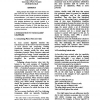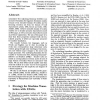14 search results - page 2 / 3 » Sentence Planning as Description Using Tree Adjoining Gramma... |
ACL
1996
13 years 6 months ago
1996
Lexicalized Tree Adjoining Grammars have proved useful for NLP. However, numerous redundancy problems face LTAGs developers, as highlighted by Vijay-Shanker and Schabes (92). We p...
ACL
1990
13 years 5 months ago
1990
according to this definition2. Each elementary tree is constrained to have at least one terminal at its frontier which serves as 'head' (or 'anchor'). Sentence...
ACL
2006
13 years 6 months ago
2006
We claim that existing specification languages for tree based grammars fail to adequately support identifier managment. We then show that XMG (eXtensible MetaGrammar) provides a s...
COGSCI
2004
13 years 4 months ago
2004
Disfluencies include editing terms such as uh and um as well as repeats and revisions. Little is known about how disfluencies are processed, and there has been next to no research...
COLING
1990
13 years 5 months ago
1990
Lexicalized Tree Adjoining Grammar (LTAG) is an attractive formalism for linguistic description mainly because cff its extended domain of locality and its factoring recursion out ...


